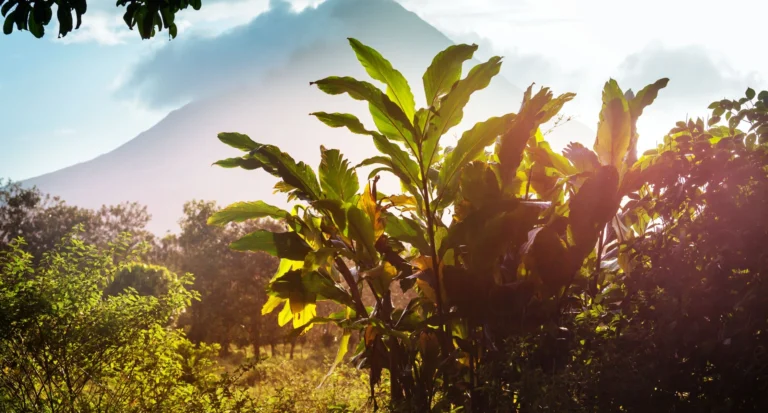Caribbean Coast, Costa Rica: What's Covered
Costa Rica’s Caribbean from Puerto Viejo to Tortuguero delivers Afro-Caribbean culture with reggae and coconut cuisine, unlike Pacific destinations. Punta Uva offers turquoise water; Cahuita National Park features Costa Rica’s largest coral reef. Tortuguero requires boat access with no roads—green turtles nest July-October. Rental cars explore beaches between Puerto Viejo and Manzanillo on well-maintained coastal roads.
Quick Facts:
- September-October brings the Caribbean’s sunny “veranillo” while the Pacific gets rain
- Route 32 from San José to Limón takes 3 hours through Braulio Carrillo
- Shuttle-boat to Tortuguero costs $85; public buses $15-25, but take 6-8 hours
- Park at La Pavona dock ($10/day) for Tortuguero boats
- Regional weather differs from Pacific patterns
Top 3 Experiences:
- Puerto Viejo Beaches – Punta Uva swimming, Cocles surfing, BriBri chocolate tours
- Cahuita Park – Coral reef snorkeling, capuchins on coastal trails
- Tortuguero Canals – Morning boat tours, turtle nesting July-October
Perfect for vacation planning with SJO connections. Stopover in San José or the Central Valley en route.
If you need any help with a Costa Rica car rental, contact us now!
Costa Rica’s Caribbean coast hits different. Forget the marimba music you’ll hear on the Pacific side – here it’s all about reggae beats floating through humid air. Instead of gallo pinto for breakfast, you’re eating rice and beans cooked in coconut milk. And that famous “pura vida” philosophy? It somehow gets even more relaxed when it meets Caribbean culture.
The stretch from Puerto Viejo to Tortuguero shows you a Costa Rica that most visitors miss entirely. You’ve got indigenous BriBri communities, Afro-Caribbean culture that arrived with Jamaican railroad workers, pristine coral reefs, and a canal system so extensive they call it “Costa Rica’s Amazon.”
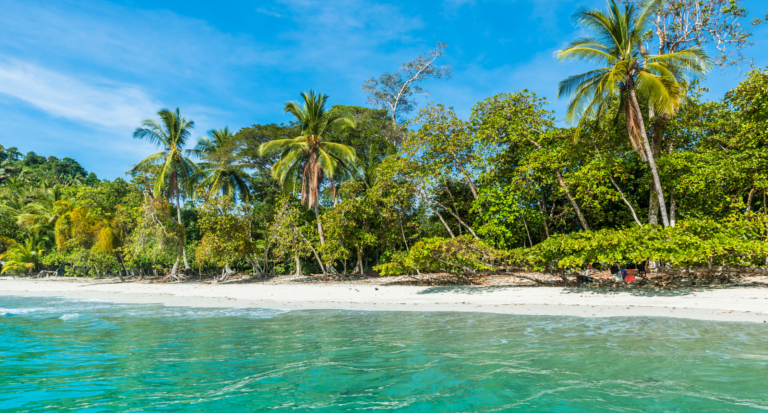
What Makes the Caribbean Coast So Different from the Pacific?
First thing you’ll notice? The weather doesn’t follow Costa Rica’s typical playbook. While the Pacific side has clear-cut dry and rainy seasons, the Caribbean does its own thing entirely.
The cultural mix here creates something special. Strong Afro-Caribbean heritage blends with indigenous traditions and Latin American influences. You’ll taste it in the food (coconut everything), hear it in the music (calypso and reggae), and feel it in the slower pace of life.
Development-wise, you won’t find the mega-resorts of Guanacaste here. Most accommodations are locally-owned, which means your money stays in the community. The beaches might not have the Instagram-perfect sunsets of the Pacific (wrong coast for that), but they make up for it with turquoise water, coconut palms, and way fewer people.
Wildlife enthusiasts, pay attention: This region specializes in animals you won’t easily spot elsewhere. Green sea turtles nest on Tortuguero’s beaches. Poison dart frogs hop through the leaf litter. Sloths hang out in cecropia trees right along the road. The biodiversity here rivals anywhere in the country.
How Did the Caribbean Coast Develop Its Unique Culture?
Where Did the Afro-Caribbean Influence Come From?
The story starts in the late 1800s when Costa Rica needed to build a railroad from San José to the Caribbean coast. They brought in workers from Jamaica and other West Indian islands to tackle this massive project through mountainous jungle.
When the railroad company went bankrupt in 1890, many workers stayed. They’d already built communities, started families, and established small farms along the coast. For decades, these communities developed separately from the rest of Costa Rica – they weren’t even allowed to travel freely to the Central Valley until 1949.
This isolation preserved their culture. Today, you’ll still hear Creole English spoken alongside Spanish. Traditional recipes passed down through generations appear in local sodas. And the musical traditions – from calypso to reggae – remain strong in the community.
What’s the Deal with Limón City?
Limón might not win any beauty contests, but this working port city pulses with authentic Caribbean culture. Most travelers skip it entirely, which is understandable – it’s rough around the edges. But if you’re interested in real cultural experiences rather than tourist shows, Limón delivers.
Time your visit for October’s Carnival if you can. For one week, the city explodes with color, music, and dancing. Elaborate costumes parade through the streets. Calypso and soca bands keep everyone moving. Food stalls serve up traditional Caribbean dishes you won’t find anywhere else in Costa Rica.
Even outside Carnival, the central market offers a taste of local life. Head there early in the morning (before 10 AM works best) for patí (spicy meat pastries that’ll wake you right up), pan bon (sweet bread loaded with dried fruits), and tropical fruits you’ve probably never seen before.
The Black Star Line building still stands as a reminder of Marcus Garvey’s influence on the region’s cultural development. It housed an organization that promoted Black empowerment and economic independence – ideas that shaped the community’s identity.
What About Indigenous Communities?
The BriBri and Kèköldi peoples have called this region home long before anyone else arrived. They’ve managed to maintain their traditions while adapting to modern challenges – no small feat.
Several communities offer cultural tours where you can learn about medicinal plants (they know uses for plants that pharmaceutical companies are just discovering), traditional cacao processing (chocolate the way it’s been made for centuries), and sustainable farming practices that work with the rainforest rather than against it.
These aren’t theme park experiences – you’re visiting actual communities where people live and work. Your visit provides direct economic support to families working to preserve their culture and protect their land.
What's Puerto Viejo Really Like?
Puerto Viejo de Talamanca started as a small fishing village. Now it’s where surfers hunting for the perfect wave meet yogis seeking enlightenment, digital nomads tap away on laptops in beachfront cafes, and locals maintain their Caribbean cool despite all the newcomers.
The town itself stretches along the coastal road, with the black sand Playa Negra on one side and shops, restaurants, and bars on the other. It’s walkable, bikeable, and impossible to get seriously lost in.
Which Beaches Should You Hit Around Puerto Viejo?
Each beach here has its own personality:
Playa Cocles draws serious surfers to its consistent waves. The famous “Salsa Brava” wave breaks over a shallow reef and will absolutely punish anyone who doesn’t know what they’re doing. But the beach itself stretches for miles with golden sand and plenty of calmer spots for swimming.
Playa Chiquita offers something completely different – small protected coves where the reef creates natural pools. Perfect for swimming without fighting waves, and the snorkeling can be decent when the water’s clear.
Playa Punta Uva wins the beauty contest hands down. Picture white sand, turquoise water so clear you can see your feet, and jungle growing right to the beach edge. The swimming here is generally calm, and the snorkeling around the point reveals parrotfish, angelfish, and occasionally a ray gliding past.
Playa Negra sits right in town, its volcanic black sand creating a striking contrast with the blue water. Not the prettiest beach for lounging, but it’s convenient and has consistent small waves perfect for beginner surfers.
Want to know a photographer’s secret? Hit Punta Uva about an hour before sunset. The light turns the jungle emerald, the sand glows golden, and the water shifts through every shade of blue and turquoise. Even your phone camera can’t mess this up.
Where Are the Best Surf Breaks?
The Caribbean’s surf scene operates on its own schedule, blessing the coast with waves when the Pacific goes flat.
Salsa Brava is the heavyweight champion here. This reef break creates powerful, hollow rights that demand respect. The wave breaks over sharp coral in shallow water – mess up and you’ll leave some skin on the reef. December through March sees the most consistent swells, but Salsa can fire up any time a strong northern swell arrives.
Playa Cocles works more often and forgives more mistakes. The beach break here handles various swell directions and sizes, making it the go-to spot for intermediate surfers. Multiple peaks spread the crowd out, and you can always find a section matching your skill level.
Playa Grande near Manzanillo needs bigger swells to work properly, but when it does, you’ll have longer rides with fewer people around. The paddle out can be challenging, but the reward is worth it.
Cahuita Point near the national park entrance only works during larger swells, but it offers something special – long, peeling lefts that are rare on this coast. Check with local surf shops about current conditions before making the trip.
Board rentals run about $15-20 per day, and lessons cost around $40-60. Start early – the wind usually picks up around 10 AM and can mess up otherwise clean conditions.
What Cultural Experiences Can You Find in Puerto Viejo?
Saturday mornings, the farmers market (feria) takes over a field near town. Local farmers bring whatever’s ripe – star fruit, soursop, passion fruit, plus vegetables you won’t find in North American supermarkets. Artisans sell handmade soaps, jewelry, and crafts. The vibe is pure community gathering, not a tourist market.
Chocolate tours show you the bean-to-bar process, but the good ones go deeper. Indigenous guides explain how cacao was currency, medicine, and ceremony for their ancestors. You’ll taste chocolate in forms you’ve never imagined – the fresh fruit is nothing like the processed stuff.
Live music happens most nights somewhere in town. Monday might be reggae night at Johnny’s Place, Wednesday could be Latin music at Koki Beach, and weekends see bands at multiple venues. These aren’t tourist shows – locals come out to dance, and you should too.
The BriBri indigenous territory sits just inland from Puerto Viejo. Visits here teach you about medicinal plants (that headache remedy might grow in your backyard), traditional chocolate making, and how to live sustainably in a rainforest. Your guide might be a grandmother who learned these traditions from her grandmother – this is living culture, not a museum.
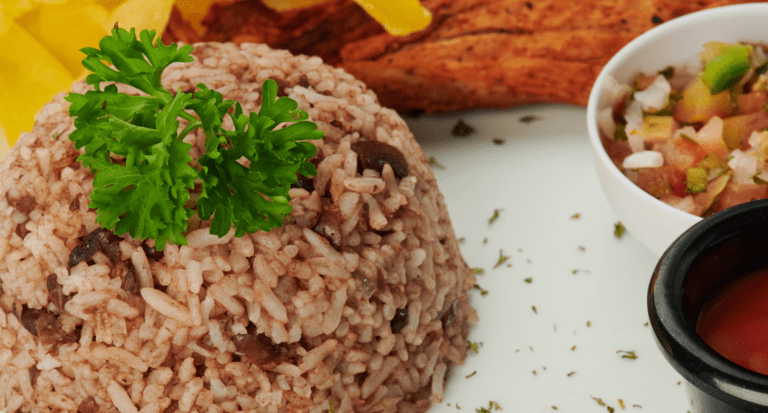
What's So Special About Caribbean Cuisine?
Forget everything you know about typical Costa Rican food. The Caribbean coast cooks with its own rulebook.
Which Flavors Define Caribbean Cooking?
Coconut changes everything here. While the rest of Costa Rica makes gallo pinto with water or broth, Caribbean cooks use coconut milk. The rice absorbs that rich, slightly sweet flavor that turns a simple side dish into something special.
Scotch bonnet peppers bring serious heat – way more than anything in traditional Costa Rican cooking. But it’s not just about burning your tongue. These peppers have a fruity, almost floral flavor that Caribbean cooks balance with sweet and savory elements.
Fresh seafood appears in everything from hearty stews to simple grilled preparations. Red snapper, lobster, shrimp, and whatever else the fishermen brought in that morning. The proximity to the source means freshness you can taste.
Slow cooking builds flavors in many signature dishes. Stews simmer for hours. Marinades work overnight. This isn’t fast food – it’s worth-the-wait food.
Which Dishes Should You Try?
Rondon (Run Down) is the dish that defines Caribbean Costa Rican cooking. Fishermen traditionally made it with whatever “run down” from the sea – fish, lobster, shrimp, maybe some crab. These cook slowly in coconut milk with yuca, plantains, and dumplings. Every cook has their own recipe, and arguments about whose is best can get heated.
Rice and Beans (not gallo pinto!) cooks the rice directly in coconut milk with red beans, thyme, and often a whole scotch bonnet pepper for flavor (removed before serving if you’re lucky). This isn’t a side dish – it’s the foundation of the meal.
Patí will save you when you need a quick lunch. These flaky pastries filled with spiced meat or fish pack enough heat to clear your sinuses. Perfect for eating while walking the beach.
Pan Bon appears in bakeries and sodas, a sweet bread loaded with dried fruits, ginger, and sometimes a splash of rum. It’s breakfast, dessert, or an afternoon snack with coffee.
Plantintá takes ripe plantains, mashes them up, forms them into patties, and fries them until crispy outside and creamy inside. Sweet, savory, and addictive.
Caribbean Chicken marinates in lime juice, garlic, thyme, and enough scotch bonnet to make you sweat. Grilled or stewed, it’s always flavorful and usually spicy enough to require a cold beer alongside.
Where Can You Find the Real Deal?
Skip the restaurants with English menus and photos of food. You want the places where locals eat lunch.
Soda Lidia’s in Puerto Viejo serves enormous plates of traditional food at local prices. The rondon here takes hours to make and sells out early on weekends.
Miss Sam’s specializes in Caribbean breakfast – ackee and saltfish, johnny cakes, and the strongest coffee on the coast.
Tamara’s does seafood right – whatever came in that morning, simply prepared and generously portioned.
The Limón central market has food stalls serving dishes you won’t find in Puerto Viejo’s tourist restaurants. This is where to try mondongo (tripe soup) if you’re adventurous, or just grab a patí for the road.
Weekend markets often have someone’s grandmother selling food from a small stand. That’s where you’ll find the most authentic flavors – recipes passed down through generations and made with love.
If you’re staying somewhere with a kitchen, buy ingredients at the market. Vendors will happily explain how to prepare dishes, and cooking with Caribbean ingredients teaches you flavors in a way restaurants can’t.
Is Cahuita Worth a Stop?
Absolutely. This small town 16 kilometers north of Puerto Viejo moves at an even slower pace. Fewer tourists, more locals, and one of Costa Rica’s most accessible national parks.
What Makes Cahuita National Park Special?
Established in 1970, Cahuita protects the largest coral reef system on Costa Rica’s Caribbean coast – about 600 acres of coral formations hosting 35 coral species and over 120 fish species. Earthquakes and sedimentation have damaged portions, but it remains the country’s most significant reef.
The park combines beach, forest, and reef in one package. An 8.5-kilometer trail runs from Kelly Creek ranger station to Puerto Vargas, staying close enough to the coast that you can hear waves the entire hike. The first two kilometers offer the most wildlife sightings without requiring serious hiking commitment.
White-faced capuchins own this place. They’ll watch you from the trees, occasionally coming down to investigate (don’t feed them – it’s illegal and changes their behavior). Howler monkeys announce themselves with roars that sound like dinosaurs. Sloths hang in cecropias digesting leaves. And if you’re lucky, you might spot the yellow eyelash viper coiled on a branch.
The park operates unusually – the southern entrance at Kelly Creek works on donations rather than fixed fees. The northern entrance at Puerto Vargas charges about $5 but puts you closer to the best snorkeling spots.
For snorkeling, you need a certified guide (rules protect the reef from too many flippers). Tours cost $30-40 including equipment and last about two hours. The reef might not match the Pacific’s Caño Island, but you’ll see parrotfish, angelfish, blue tangs, and maybe a turtle cruising past.
Show up at 6 AM when the park opens. Animals are most active, temperatures are cooler, and you’ll have the trail mostly to yourself for the first hour.
What’s Cahuita Town Like?
Cahuita feels like Puerto Viejo’s quieter cousin. One main street runs through town with colorful wooden buildings that have been here for decades. The central park faces the ocean – a perfect spot for watching local life unfold.
Small family-run cabinas and guesthouses provide most accommodation. Nothing fancy, but you’ll fall asleep to ocean sounds and wake up to howler monkeys. Many places have gardens that attract birds and butterflies.
Restaurants here focus on local food for local people, not tourist versions. Prices reflect this – you’ll pay less than in Puerto Viejo for bigger portions of more authentic food.
Beyond the national park, you can arrange horseback rides along the beach (best at sunset), climb trees with specialized guides (harder than it looks), or visit the Cahuita Animal Rescue Center, which rehabilitates injured wildlife with a focus on release rather than display.
Weekend evenings, check the central park for domino games. It’s serious business here – money changes hands, arguments get loud, and the skill level is impressive. Pull up a chair to watch, and someone will probably explain the rules and offer you a beer.
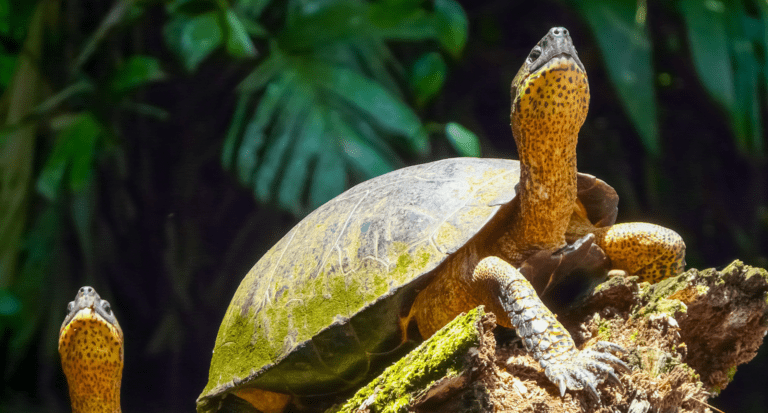
Why Do People Call Tortuguero "Costa Rica's Amazon"?
Tortuguero National Park feels like entering another world. No roads reach this water-bound wilderness – you arrive by boat or small plane, immediately understanding why they make the Amazon comparison.
What Will You See in Tortuguero National Park?
Established in 1975 primarily to protect nesting sea turtles, this 77,032-acre park now ranks among Costa Rica’s premier wildlife destinations.
The canal network creates the magic here. Natural and human-made waterways wind through dense jungle, creating corridors for wildlife viewing. Early morning boat tours reveal the forest waking up – howler monkeys starting their daily roar, toucans flying between trees, and caimans sunning on logs.
Four turtle species nest on these beaches. Green turtles arrive July through October (peak in August-September). Leatherbacks come February through April. Hawksbills and loggerheads appear less predictably but still regularly. Watching a massive sea turtle dig her nest and lay eggs under the stars creates memories that last forever.
The biodiversity numbers impress even scientists: over 400 bird species, more than 60 mammal species, plus countless reptiles, amphibians, and insects. The varied ecosystems – mangroves, rainforest, swamps, beaches – create niches for all this life.
When’s the Best Time for Wildlife in Tortuguero?
Wildlife viewing stays excellent year-round, but different seasons offer different highlights.
Green turtle nesting (July-October) draws the biggest crowds for good reason. Guided night walks let you witness this ancient ritual. Tours strictly control group sizes and prohibit flash photography to minimize disturbance.
Outside turtle season, canal wildlife takes center stage. Morning boat tours spot spider monkeys, three-toed sloths, river otters, and endless birds. Jesus Christ lizards run across the water. Poison dart frogs hop through leaf litter on jungle trails.
The “shoulder seasons” (May-June and November-December) offer smaller crowds and active wildlife. Rain increases in November-December but usually comes in afternoon bursts that don’t affect morning activities.
Discover more amazing wildlife viewing locations throughout the country in our Wildlife Viewing Hotspots in Costa Rica guide.
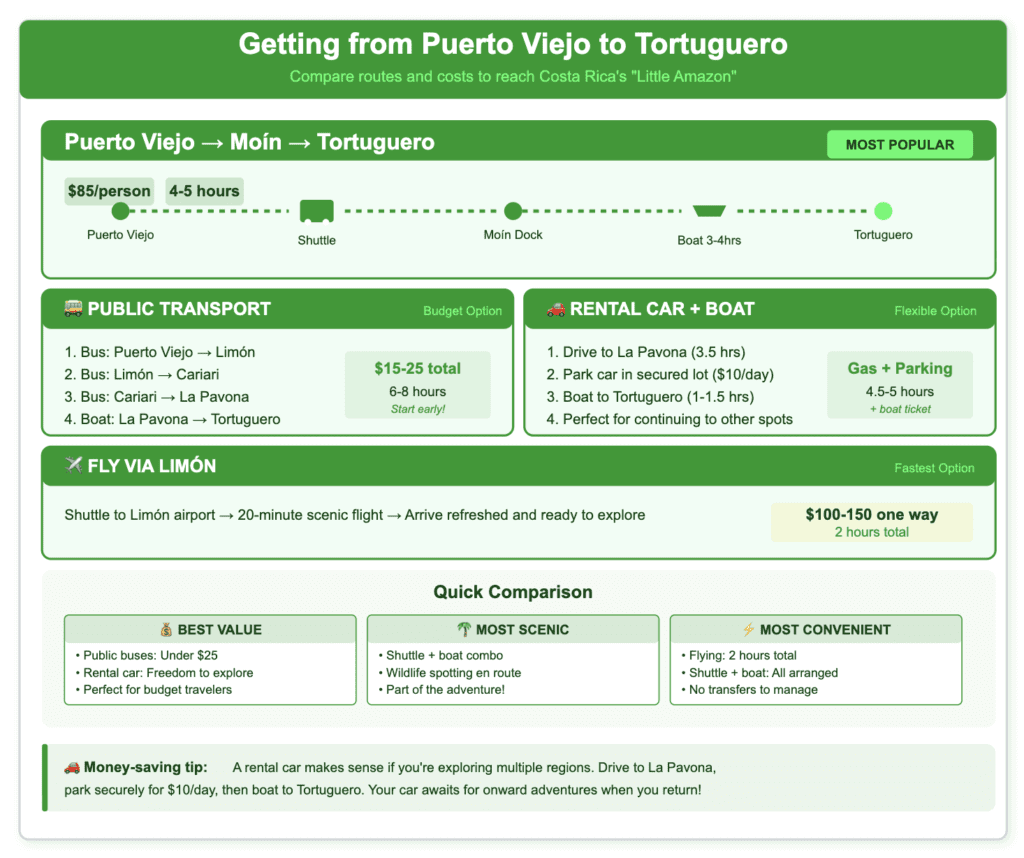
How Do You Actually Get from Puerto Viejo to Tortuguero?
Should You Take the Scenic Boat Route?
The shuttle-boat combination offers the most popular route for good reason. You’ll get picked up at your Puerto Viejo hotel, drive to Moín dock (near Limón), then board a boat for a 3-4 hour journey through canals and along the coast.
This boat ride becomes part of your Tortuguero experience. You’ll spot sloths hanging over the water, monkeys in riverside trees, caimans sunning on banks, and countless birds. Some boat captains double as nature guides, pointing out wildlife and explaining the ecosystem.
Several companies run this route with departures around 6 AM and noon. The $85 per person price includes hotel pickup, land transportation, and the boat ride. Book at least a day ahead during the high season.
Can You Do It Cheaper with Public Transportation?
Yes, but it requires patience and flexibility. Take the public bus from Puerto Viejo to Limón ($2-3, about 1 hour), then either grab a taxi to Moín for a boat, or continue by bus to Cariari, then La Pavona, and finally boat to Tortuguero.
Start early – the last public boats from La Pavona leave around 4:30 PM. Miss that and you’re stuck overnight. Total cost runs $15-25, but add 2-3 hours to your journey and expect some confusion at transfer points.
What If You Have a Rental Car?
Having your own wheels gives you flexibility for the land portion. Drive from Puerto Viejo to La Pavona dock (about 3.5 hours), park in the secured lot ($10 per day), then catch a boat to Tortuguero (1-1.5 hours).
The road to La Pavona stays paved most of the way, though the final stretch can get rough during heavy rains. Your car stays safe with attendants watching the parking area. This option works great if you’re continuing to other destinations after Tortuguero.
Is Flying Worth the Extra Cost?
If time matters more than money, fly from Limón to Tortuguero. The 20-minute flight costs $100-150 one way but saves hours of travel. Small planes provide aerial views of the canals and coastline you won’t get any other way.
Limited schedules mean planning ahead. Only a couple flights operate daily, and weather can cause cancellations. Book directly with Sansa or Green Airways.
For travelers flying into Costa Rica, our Complete Guide to Juan Santamaría International Airport (SJO) provides helpful information for navigating your arrival.
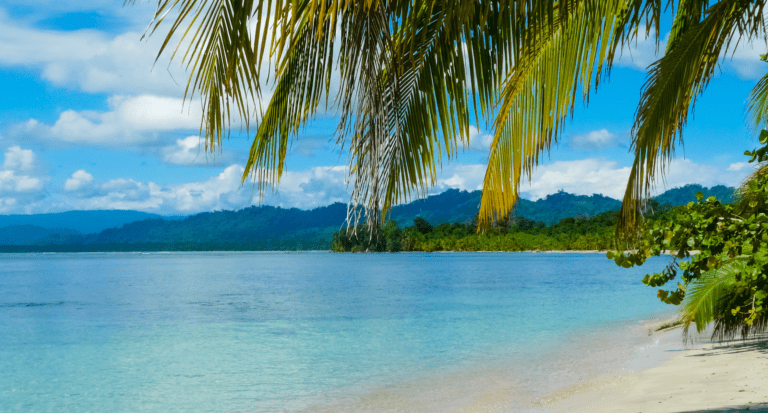
When Should You Visit the Caribbean Coast?
Why Are September and October Special?
While rain pounds the Pacific coast and Central Valley during these months, the Caribbean often enjoys beautiful weather. Locals call it “veranillo” (little summer), and it’s one of the coast’s best-kept secrets.
The water clears up for excellent snorkeling visibility. Humidity drops to bearable levels. Tourist numbers hit annual lows, so you’ll have beaches largely to yourself. Green turtles nest in Tortuguero at peak numbers. And accommodations offer their best rates of the year.
Costa Ricans from the Central Valley know this secret. They fill the coast during these months, creating a fun local vibe without international tourist crowds.
When Do the Turtles Show Up?
Different species follow different schedules:
Green turtles nest July through October with peak activity in August and September. Tortuguero hosts one of the largest nesting populations in the Atlantic.
Leatherback turtles arrive February through April on northern beaches and Gandoca. These massive turtles (up to 700kg!) create an unforgettable sight.
Hawksbill turtles nest May through November but in smaller numbers. You might get lucky and spot one, but don’t plan a trip around it.
All turtle viewing requires certified guides who know how to minimize disturbance. Tours typically run $35-40 per person. No flash photography, no touching, and groups stay small. The turtles’ wellbeing comes first.
What’s the Weather Like Year-Round?
The Caribbean doesn’t follow Costa Rica’s typical weather patterns:
December-April brings the “dry” season, though rain still falls regularly. Expect morning sunshine with possible afternoon showers. This is the high season with corresponding prices and crowds.
May-August sees increasing rainfall, typically as afternoon thunderstorms. Mornings stay clear for activities. Wildlife viewing excels as animals stay active in the cooler weather.
November-December can get seriously wet, but wildlife watching remains excellent. Few tourists brave the rain, so you’ll have attractions to yourself. Prices drop significantly.
Pack rain gear no matter when you visit. Even in the driest months, quick showers happen. The warm temperatures (averaging 25-30°C/77-86°F) mean getting wet isn’t uncomfortable – it’s often refreshing.
For a complete breakdown of weather throughout Costa Rica’s diverse regions, see our guide to Costa Rica’s Regional Weather Patterns.
Where Should You Stay on the Caribbean Coast?
What Are Your Options in Puerto Viejo?
Puerto Viejo’s accommodations match its eclectic character. Beachfront bungalows range from basic wooden cabins ($30-50/night) to upscale retreats with private pools ($150+/night). Most fall somewhere in the middle – comfortable, characterful, and close to the beach.
Staying in town puts you walking distance from restaurants and nightlife but means more noise and less nature. The sweet spot might be the areas just outside town – Cocles, Chiquita, and Punta Uva. You’ll get better beaches, jungle settings, and more peace while staying within a short bike ride or drive of town action.
Jungle lodges set back from the beach offer wildlife viewing from your porch. Howler monkeys as alarm clocks, toucans at breakfast, and sloths in the garden aren’t unusual. These properties often focus on sustainability with solar power, rainwater collection, and organic gardens.
Hostels and guesthouses cater to backpackers and longer-term travelers. Roki’s, Pagalu, and Kinkajou Lodge have built communities where solo travelers easily meet others. Expect to pay $15-25 for dorms, $40-60 for private rooms.
How Does Tortuguero Lodging Work?
Tortuguero’s isolation shapes accommodation options. Most visitors stay at all-inclusive lodges along the canals outside the village. Packages typically include meals, transportation from San José, and some guided activities. Prices run $150-400 per person per night depending on luxury level.
These lodges range from scientific research stations accepting guests to elaborate eco-resorts with pools and spas. The experience stays similar – you’re in the jungle, surrounded by wildlife, with boats as your primary transportation.
Budget travelers can stay in Tortuguero village itself. Simple hotels and cabinas cost $30-60/night, and you can eat at local restaurants rather than lodge dining rooms. You’ll arrange your own tours, but prices are competitive and you’ll interact more with the local community.
Book Tortuguero accommodations months ahead for turtle season (July-October). Lodges fill up, and even budget options in the village become scarce. Outside turtle season, you can be more spontaneous.
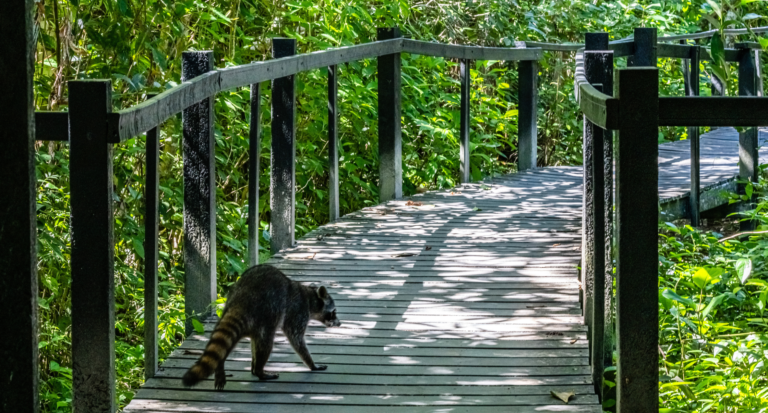
What Else Should You See Between Puerto Viejo and Tortuguero?
Is Cahuita National Park Worth the Stop?
Cahuita’s park absolutely deserves a visit. The coral reef here spans 600 acres with 35 coral species and 123 fish species. Snorkeling tours (required to have a guide) cost $30-40 and reveal parrotfish, angelfish, blue tangs, and occasional turtles.
The coastal trail offers easier wildlife spotting than many parks. White-faced capuchins are practically guaranteed. Howler monkeys announce themselves regularly. Sloths hang in cecropias near the trail. The flat 8.5-kilometer path means all fitness levels can enjoy at least part of it.
Enter from the southern Kelly Creek entrance (donation-based) for the most popular trail section. The northern Puerto Vargas entrance ($5 fee) puts you closer to the best snorkeling areas.
What’s Special About Manzanillo Wildlife Refuge?
South of Puerto Viejo, this protected area combines pristine beaches with healthy forest. The beaches here photograph like postcards – white sand, clear water, jungle backdrop. When seas are calm, snorkeling reveals abundant marine life.
Well-maintained trails wind through primary and secondary forest. Hire a local guide for the challenging hike to Punta Mona. This full-day adventure leads to remote beaches and viewpoints most visitors never see. The trail can be muddy and steep, but the payoff is worth the effort.
Should You Stop at Braulio Carrillo National Park?
If driving between San José and the Caribbean, this mountainous park offers a dramatic transition from highland to lowland ecosystems. The park itself protects vast tracts of primary forest visible from the highway.
The Rainforest Aerial Tram glides through and above the canopy, offering perspectives impossible from the ground. Several spectacular waterfalls are visible from roadside viewpoints. If time allows, stop at the visitor center for short trails and educational displays.
The highway through the park features spectacular scenery but challenging driving. Fog, rain, and winding roads require full attention. Allow extra time and consider breaking up the drive with strategic stops.
After exploring the park, you might consider spending time in the surrounding highland region. Our guide to Exploring Costa Rica’s Central Valley details the attractions in this diverse area.
Thinking About Crossing to Panama?
Many Caribbean coast visitors continue to Panama’s Bocas del Toro archipelago. The Sixaola border crossing, 30 minutes south of Manzanillo, makes this easy enough for a natural extension of your trip.
What Do You Need for the Border Crossing?
Bring your passport (valid for six months), proof of onward travel from Panama (plane or bus ticket works), and evidence of funds ($500 cash or credit card statement). The crossing costs $8 to exit Costa Rica and $3 to enter Panama.
The border operates 7 AM to 5 PM. Costa Rican immigration processes your exit, you walk across the bridge, then Panamanian immigration handles entry. The whole process takes 30-60 minutes unless it’s a busy weekend or holiday.
Cross in the morning to reach Bocas del Toro before dark. Afternoon crossings risk missing the last boats to the islands.
How Do You Reach Bocas del Toro from the Border?
After crossing, take a collective taxi or bus to Changuinola (30-45 minutes), then another to Almirante (45 minutes), and finally a water taxi to Isla Colón in Bocas (30 minutes). Total cost runs about $15-20.
Shuttle services from Puerto Viejo handle the entire journey for $30-40 per person. They manage border formalities and connections, saving hassle especially for first-time crossers.
Is Bocas del Toro Worth Adding?
Bocas offers true island life – something Costa Rica’s mainland can’t match. Different beaches on various islands mean boat rides become part of daily life. The snorkeling and diving here reveal coral formations not found on Costa Rica’s Caribbean coast. The vibe mixes Caribbean culture with backpacker energy and growing expat influence.
Plan 3-5 days minimum to make the border crossing worthwhile. This gives you time to explore multiple islands without rushing. Many travelers find Bocas makes a perfect ending before flying out of Panama City instead of backtracking through Costa Rica.
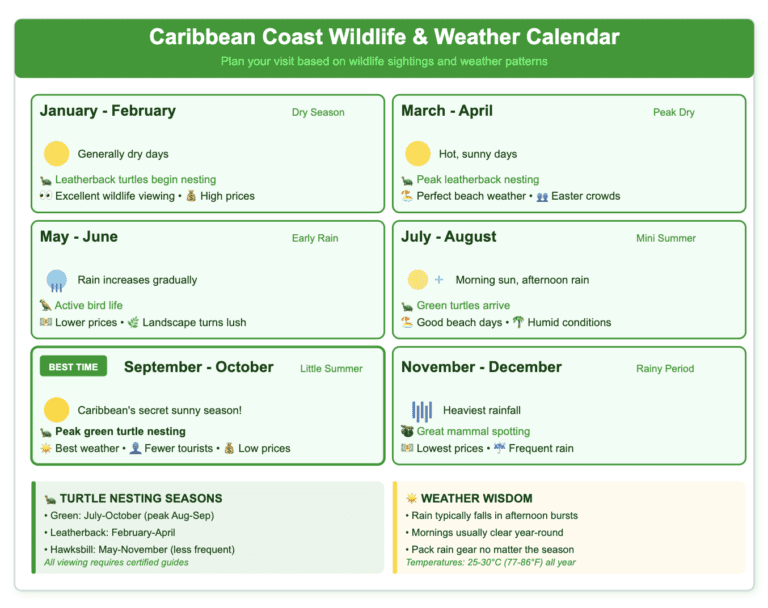
What Do You Really Need to Pack?
The Caribbean coast’s humidity changes everything. That cotton shirt that dries overnight on the Pacific side? It’ll still be damp three days later here. Pack quick-dry everything – shirts, shorts, even underwear if you can find it.
Insect repellent isn’t optional. Mosquitoes are manageable, but sand flies (purrujas) can be vicious around dawn and dusk. DEET or picaridin at 20%+ concentration works best. Natural alternatives rarely cut it here.
Reef-safe sunscreen protects both you and the coral ecosystems. Look for mineral-based formulas with zinc oxide or titanium dioxide. Chemical sunscreens damage coral, and several beaches are starting to ban them.
Water shoes save your feet on rocky beaches and boat docks. They also protect against sea urchins when snorkeling. Cheap ones from home work better than expensive ones bought at inflated tourist prices.
Dry bags keep essentials safe during boat rides and sudden downpours. A 10-20 liter bag holds a phone, camera, and documents. Ziploc bags work in a pinch but won’t survive multiple trips.
Pack less clothing than you think you need. Laundry services are everywhere and cheap (about $5-8 per load). The relaxed Caribbean atmosphere means you can wear the same shirt to breakfast and dinner without judgment.
How Should You Handle Transportation?
What Are the Road Conditions Really Like?
Route 32 from San José to Limón stays in good condition most of the year, though heavy rains can cause temporary closures. The road winds through Braulio Carrillo National Park with spectacular scenery but requires attention – fog appears suddenly, and trucks barrel through at surprising speeds.
From Limón south to Puerto Viejo, the coastal road is flat and straightforward. From Puerto Viejo continuing south to Manzanillo, expect some potholes and rough patches, especially after heavy rain.
Do You Need a Rental Car?
A car gives you freedom to explore beaches and attractions at your own pace. You can stop at roadside fruit stands, chase wildlife sightings, and reach places buses don’t go. For Puerto Viejo and surroundings, a standard car works fine during dry conditions. In the rainy season or for exploring inland, a bit more clearance helps.
For Tortuguero, you’ll park at La Pavona dock ($10/day) and continue by boat. The secured lot has attendants watching vehicles 24/7. This works well if continuing to other destinations after Tortuguero.
Bicycles are huge in Puerto Viejo. The flat coastal road and short distances between beaches make cycling perfect. Rentals cost about $10/day. Just watch for the occasional pothole and drivers who assume cyclists don’t exist.
Public boats in Tortuguero run like buses on water. You can catch boats between the village and various lodges throughout the day. In Puerto Viejo, the bus to Manzanillo runs hourly and costs about $1.
For detailed information about driving conditions, traffic rules, and road signage, check our comprehensive Driving in Costa Rica: What to Expect on the Roads guide.
What About Health and Safety?
Tap water in established businesses is safe to drink. If staying in remote areas or your stomach is sensitive, bottled water is available everywhere.
The sun here hits harder than you expect, even through clouds. Reapply sunscreen every two hours when swimming. That “base tan” from home won’t protect you from the equatorial sun.
Some beaches have dangerous rip currents. Cocles and Playa Negra can get rough. Punta Uva and the beaches in Manzanillo typically stay calmer. When you see red flags or no one else swimming, there’s probably a reason.
Wildlife is everywhere, which is amazing until a monkey steals your breakfast. Don’t feed animals – it’s illegal and changes their natural behavior. Keep food secured and maintain respectful distances. That sloth might look cuddly, but those claws are serious business.
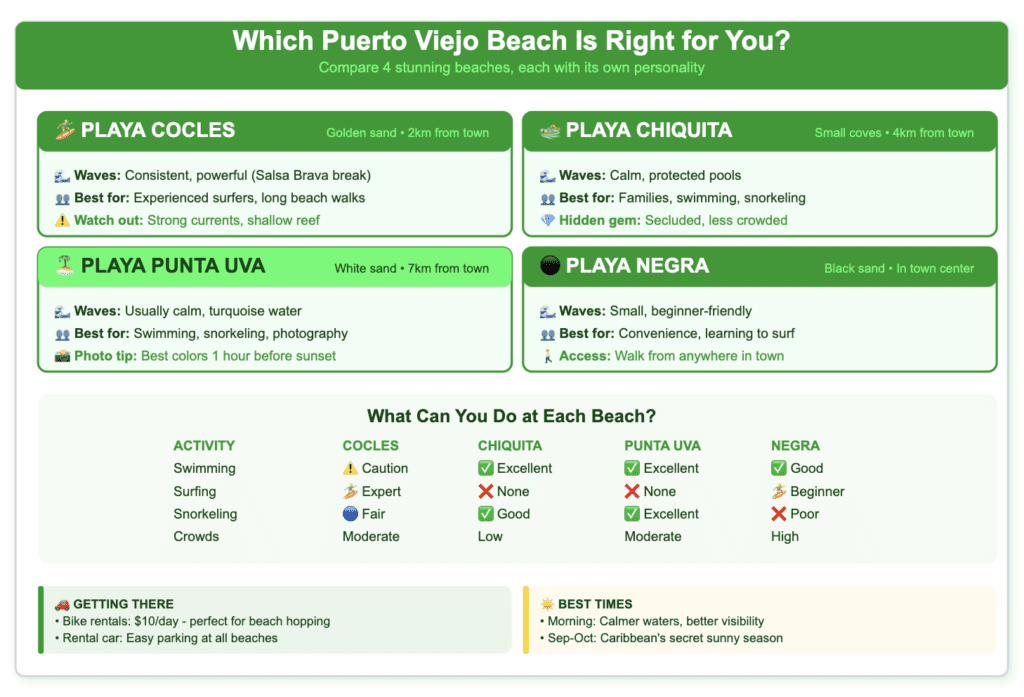
Sample Itineraries That Actually Work
Got 5 Days? Here’s What Makes Sense:
- Day 1: Land in Puerto Viejo, get your bearings, walk Playa Negra, eat rice and beans at a local soda.
- Day 2: Morning at Cahuita National Park (arrive by 7 AM), snorkel in the afternoon, back to Puerto Viejo for live music.
- Day 3: Early shuttle to La Pavona, boat to Tortuguero, afternoon exploring the village.
- Day 4: Morning canal tour (6 AM start for best wildlife), afternoon jungle hike or kayaking.
- Day 5: Morning departure from Tortuguero, connect to your next destination.
Have a Full Week? Add These Experiences:
- Day 1: Arrive in Puerto Viejo via San José, settle in, explore town.
- Day 2: Morning chocolate tour with BriBri community, afternoon at Punta Uva beach.
- Day 3: Day trip to Manzanillo Wildlife Refuge, snorkel if conditions allow.
- Day 4: Transfer to Tortuguero via scenic boat route from Moín.
- Day 5: Full day in Tortuguero – morning canal tour, afternoon village exploration, night turtle tour if in season.
- Day 6: Morning kayaking or fishing in Tortuguero, afternoon departure.
- Day 7: Return to San José or continue to the next region.
This itinerary allows for weather delays and includes a buffer day. In the Caribbean, flexibility beats rigid scheduling every time.
If starting your journey in San José, our San José, Costa Rica: Complete Capital City Guide for Travelers offers suggestions for making the most of your time in the capital.
Ready to Experience the Caribbean Side?
The Caribbean coast shows you a Costa Rica that many visitors never discover. From the moment you catch that first whiff of coconut rice in Puerto Viejo to your last boat ride through Tortuguero’s canals, this region operates on its own timeline and terms.
You’ll taste it in the scotch bonnet heat of a proper rondon. Hear it in the reggae rhythms drifting from beach bars. Feel it in the humid air that makes everything move a little slower. See it in the traditional wooden houses painted Caribbean bright.
This journey from Puerto Viejo to Tortuguero isn’t just about checking off attractions. It’s about experiencing a cultural blend found nowhere else in Central America, witnessing wildlife spectacles like ancient turtles returning to their nest, and discovering that sometimes the best part of travel is when plans dissolve into “whatever happens, happens.”
Having your own wheels for the Puerto Viejo portion lets you chase perfect beach conditions, stop for roadside coconuts, and explore at Caribbean pace rather than bus schedules. The freedom to pull over when you spot a sloth or decide that beach needs investigating – that’s when trips become adventures.
For more information on planning your perfect Costa Rica vacation, including detailed itineraries that incorporate the Caribbean coast with other regions, see our Planning the Ultimate Costa Rica Vacation Guide. And if you’re just beginning to plan your Costa Rica adventure, our Choosing the Right Costa Rica Airport: Your Gateway to Paradise provides essential information for starting your journey on the right foot.
The Caribbean coast is waiting. Time to experience the rhythm of rice and beans, reggae, and rain.
